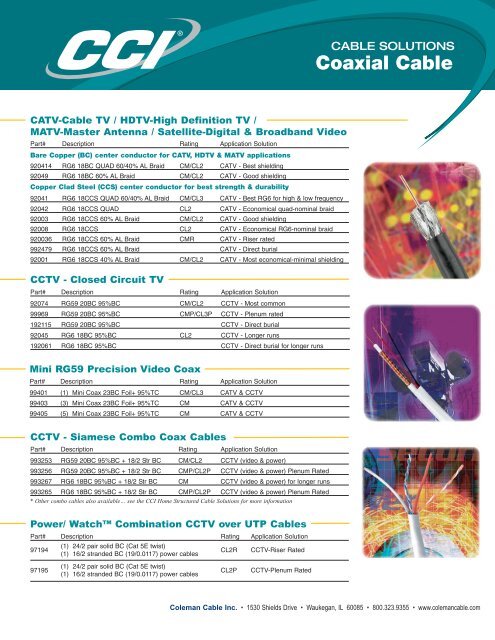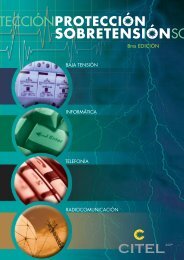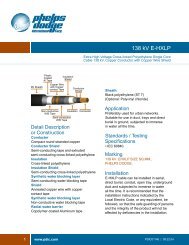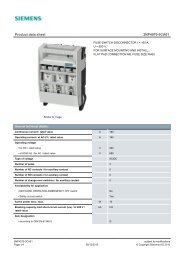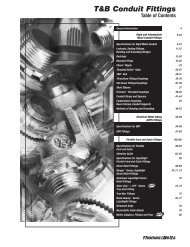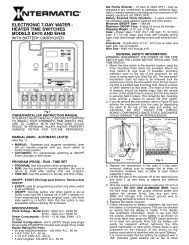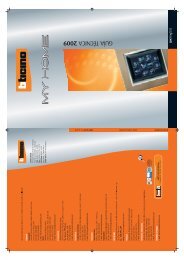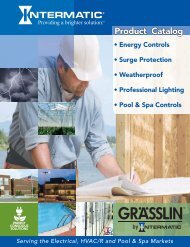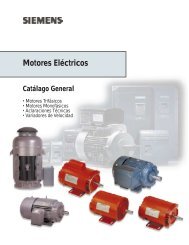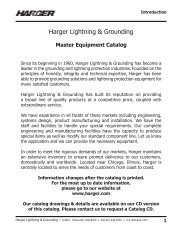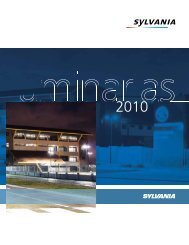Coaxial Cable Solutions:Layout 1.qxd - CCIXpress
Coaxial Cable Solutions:Layout 1.qxd - CCIXpress
Coaxial Cable Solutions:Layout 1.qxd - CCIXpress
You also want an ePaper? Increase the reach of your titles
YUMPU automatically turns print PDFs into web optimized ePapers that Google loves.
CABLE SOLUTIONS<br />
<strong>Coaxial</strong> <strong>Cable</strong><br />
CATV-<strong>Cable</strong> TV / HDTV-High Definition TV /<br />
MATV-Master Antenna / Satellite-Digital & Broadband Video<br />
Part# Description Rating Application Solution<br />
Bare Copper (BC) center conductor for CATV, HDTV & MATV applications<br />
920414 RG6 18BC QUAD 60/40% AL Braid CM/CL2 CATV - Best shielding<br />
92049 RG6 18BC 60% AL Braid CM/CL2 CATV - Good shielding<br />
Copper Clad Steel (CCS) center conductor for best strength & durability<br />
92041 RG6 18CCS QUAD 60/40% AL Braid CM/CL3 CATV - Best RG6 for high & low frequency<br />
92042 RG6 18CCS QUAD CL2 CATV - Economical quad-nominal braid<br />
92003 RG6 18CCS 60% AL Braid CM/CL2 CATV - Good shielding<br />
92008 RG6 18CCS CL2 CATV - Economical RG6-nominal braid<br />
920036 RG6 18CCS 60% AL Braid CMR CATV - Riser rated<br />
992479 RG6 18CCS 60% AL Braid CATV - Direct burial<br />
92001 RG6 18CCS 40% AL Braid CM/CL2 CATV - Most economical-minimal shielding<br />
CCTV - Closed Circuit TV<br />
Part# Description Rating Application Solution<br />
92074 RG59 20BC 95%BC CM/CL2 CCTV - Most common<br />
99969 RG59 20BC 95%BC CMP/CL3P CCTV - Plenum rated<br />
192115 RG59 20BC 95%BC CCTV - Direct burial<br />
92045 RG6 18BC 95%BC CL2 CCTV - Longer runs<br />
192061 RG6 18BC 95%BC CCTV - Direct burial for longer runs<br />
Mini RG59 Precision Video Coax<br />
Part# Description Rating Application Solution<br />
99401 (1) Mini Coax 23BC Foil+ 95%TC CM/CL3 CATV & CCTV<br />
99403 (3) Mini Coax 23BC Foil+ 95%TC CM CATV & CCTV<br />
99405 (5) Mini Coax 23BC Foil+ 95%TC CM CATV & CCTV<br />
CCTV - Siamese Combo Coax <strong>Cable</strong>s<br />
Part# Description Rating Application Solution<br />
993253 RG59 20BC 95%BC + 18/2 Str BC CM/CL2 CCTV (video & power)<br />
993256 RG59 20BC 95%BC + 18/2 Str BC CMP/CL2P CCTV (video & power) Plenum Rated<br />
993267 RG6 18BC 95%BC + 18/2 Str BC CM CCTV (video & power) for longer runs<br />
993265 RG6 18BC 95%BC + 18/2 Str BC CMP/CL2P CCTV (video & power) Plenum Rated<br />
* Other combo cables also available… see the CCI Home Structured <strong>Cable</strong> <strong>Solutions</strong> for more information<br />
Power/ Watch Combination CCTV over UTP <strong>Cable</strong>s<br />
Part# Description Rating Application Solution<br />
97194<br />
(1) 24/2 pair solid BC (Cat 5E twist)<br />
(1) 16/2 stranded BC (19/0.0117) power cables<br />
CL2R<br />
CCTV-Riser Rated<br />
97195<br />
(1) 24/2 pair solid BC (Cat 5E twist)<br />
(1) 16/2 stranded BC (19/0.0117) power cables<br />
CL2P<br />
CCTV-Plenum Rated<br />
Coleman <strong>Cable</strong> Inc. • 1530 Shields Drive • Waukegan, IL 60085 • 800.323.9355 • www.colemancable.com
CABLE SOLUTIONS<br />
<strong>Coaxial</strong> <strong>Cable</strong><br />
What Really Matters in Selecting the<br />
RIGHT Coax <strong>Cable</strong><br />
The application determines what's important in selecting the right cable;<br />
however there are some overall conditions to watch out for in all coax cables<br />
to make sure your installers do not incur costly call-backs.<br />
Overall<br />
DIELECTRIC: Too loosely extruded on the center conductor… the cable<br />
won't hold a signal. Too tightly extruded…the residue left on the center<br />
conductor when the ends are stripped can result in a poor connectorization<br />
and cause signal problems.<br />
JACKET: PVC…most commonly used compound because it provides<br />
sufficient protection, flexibility and offers a temperature rating of -40 o C to<br />
80 o C. Some companies "cheapen" the product by manufacturing the bare<br />
minimum jacket thickness, using compounds that are very hard, or extruding<br />
the jacket very tightly to the dielectric. Too small diameter…connectors<br />
won't stay on the cable, too hard jacket…installer can't get the connector on<br />
the end, too tight jacket…installer has difficulty stripping the end<br />
CATV, HDTV & MATV Applications<br />
(<strong>Cable</strong>, High Definition, Master Antenna, Digital & Satellite)<br />
CENTER CONDUCTOR: Most applications use copper clad steel<br />
(CCS). Yet, the latest technology in satellite dishes recommend a bare<br />
copper center conductor to carry power to the dish to operate the LNBs.<br />
You may recommend that installers use BC center conductors in case the<br />
owner eventually wants to add a satellite dish, he won't have to run new<br />
coax cable.<br />
SHIELDING: Foil and Braid shielding are important to insure<br />
coverage for both the high and low frequencies (see chart). Local<br />
codes often dictate the amount of shielding required. Some markets only<br />
allow RG6 Quad 60/40%, while in others, RG6 60% or 40% are acceptable.<br />
The use of a Quad shield will cover all applications and eliminate the<br />
risk of interference for the user. The RG6 40% is the lower cost product.<br />
The risk of using RG6 40% is problems with signal interference once the<br />
cable is installed. Installers do not want to waste time on call-backs<br />
because the user can't get the higher channels or they’re having radio<br />
interference. Opt for Quad shield… most cable TV systems today use<br />
up to 2.2 GHz of brand-width. With digital TV, you need 1gig; but many<br />
installers use 2.2 GHz to future-proof. Most CCI coax for CATV & Satellite<br />
TV is swept to 3.0 GHz.<br />
CCTV Applications<br />
(Security Cameras)<br />
CENTER CONDUCTOR: Solid bare copper (BC) is used because it<br />
has the best signal strength at low frequencies and will reduce the<br />
chance of distortion and line loss. The size of the center conductor is<br />
typically specified by the manufacturer of the camera. For longer<br />
runs…recommend a RG6 or RG11. For shorter runs or space<br />
constraints… recommend a RG59 or mini-coax. For example: in a casino<br />
where there can be as many as 25 cameras in a 25sq-ft area, the mini-coax<br />
may connect the cameras to a center console and a RG6 may be used as<br />
a main run back to the central station.<br />
SHIELDING: Most applications use a bare copper braid (BC)<br />
typically 95%. No need for foil shielding…because CCTV operates at<br />
low frequencies.<br />
Identify the Application<br />
● CATV (Community Antenna Television) ● Satellite<br />
● CCTV (Closed Circuit Television) ● Broadcast Video<br />
● MATV (Master Antenna Television) ● LAN (Local Area Network)<br />
● HDTV (High Definition Television)<br />
Frequency:<br />
● High Frequency Application (such as: satellite or digital)<br />
● Low Frequency Application (such as: security cameras)<br />
Foil/Braid Shielding<br />
Excellent<br />
Good<br />
Fair<br />
SHIELD: Foil/Braid<br />
In CATV and<br />
Satellite<br />
Applications:<br />
Both braid and foil<br />
shielding are important<br />
to insure coverage for<br />
both high and low<br />
frequency applications.<br />
More on Coax<br />
Attenuation: Lower is better. Attenuation refers to the loss of<br />
signal strength in the cable from initial point of the signal to<br />
destination. The more attenuation you have, the less signal is<br />
present at the receiver. Attenuation is influenced by the dielectric<br />
quality more than the braid coverage.<br />
"Swept to 3.0 gig": The results of the sweep-test are more<br />
important than just being "swept". Some companies readily print<br />
"swept to 3.0 gig" on their cables, packaging or spec sheets. It's<br />
important to insure that the results of the test are sufficient to<br />
provide protection (against EMI and RFI) and ample signal<br />
strength for the application. For CATV, HDTV satellite and digital<br />
cable, it is especially important to use a quality cable to insure<br />
that the owner has ample signal strength in the higher channels<br />
of the spectrum.<br />
Shielding: Determines the level of protection from interference<br />
that is allowed in the signal and that is leaked out of cable.<br />
Shielding provides protection from EMI & RFI.<br />
EMI: Electromagnetic interference (caused by electric motors,<br />
ballasts, & other high voltage currents)<br />
RFI: Radio Frequency Interference (such as: cell phones,<br />
radio towers or garage door openers)<br />
Jacket Compounds:<br />
● PVC is most commonly used because it provides sufficient<br />
protection and flexibility. Temperature rating: -40 o C to 80 o C.<br />
● PE (polyethylene) for direct burial. Temperature rating: -55 o C<br />
to 85 o C.<br />
Center Conductors:<br />
● CCS (copper clad steel) provides best durability and strength.<br />
Often used in CATV, HDTV and MATV applications.<br />
● BC (bare copper) offers the best signal strength at low<br />
frequencies & used in most CCTV applications.<br />
Coleman <strong>Cable</strong> Inc. • 1530 Shields Drive • Waukegan, IL 60085 • 800.323.9355 • www.colemancable.com<br />
LT541-06-01 SEPT10 R3


